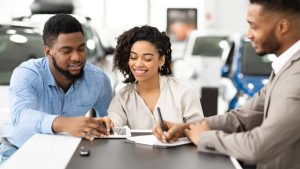Our writers and editors used an in-house natural language generation platform to assist with portions of this article, allowing them to focus on adding information that is uniquely helpful. The article was reviewed, fact-checked and edited by our editorial staff prior to publication.
The U.S. public safety net can be a catch-22: It acts as a lifeline to basic needs for people with disabilities, but it bars people from meaningfully saving, investing and building personal wealth. Money stashed in a retirement account or brokerage account counts against the small, strict asset limits imposed by certain benefit programs such as Medicaid and food stamps.
For years, disability rights groups lobbied lawmakers in Washington D.C. to change this. They finally succeeded in 2014 when the Stephen Beck, Jr. Achieving a Better Life Experience Act (ABLE) became law.
“There’s a huge opportunity for folks to invest long-term in these accounts,” says Thomas Foley, director of the National Disability Institute, a Washington D.C.-based nonprofit organization focused on improving the economic well-being of people with disabilities.
“If you’ve been on SSI or federal benefits your whole life, an ABLE account might be the first opportunity you’ve ever had to invest,” adds Foley.
What is an ABLE account?
An ABLE account is a tax-advantaged savings and investment account available to eligible people with disabilities.
Established in 2014, these accounts allow people to save and invest money without losing eligibility for certain public benefits like Supplemental Security Income (SSI) or Medicaid.
These needs-based programs enforce strict asset limits, typically just $2,000, across traditional savings and investment accounts.
But up to $100,000 in an ABLE account doesn’t count against resource limits that determine public benefit eligibility.
That can be a game changer for people with disabilities and their families, says Matt Stagner, a certified financial planner and a lead advisor at Foster Group.
“Those benefit programs are designed to essentially keep people at or just below the poverty line,” he says. “But people want the opportunity to build up some financial independence, and ABLE accounts are a pretty groundbreaking way for people with disabilities to do that.”
But you don’t need to receive public benefits to enroll in an ABLE account.
“I’m totally blind and I max out my 401k at work,” says Foley. “But having access to an ABLE account gives me even more ways to save and invest.”
Contributions can grow tax-free in an ABLE account and be withdrawn tax-free when used for qualified disability expenses.
Each state administers its own ABLE account program, similar to 529 education plans. You can open an ABLE account on your state program’s website.
Who can open an ABLE account?
Not everyone with a disability can open an ABLE account. To qualify, your disability must have started before you turned 26 years old. There’s no age limit to open an account though.
Your disability also needs to be considered significant. There are two ways to meet this requirement:
- Receiving SSI or SSDI: If you receive SSI or Social Security Disability Insurance (SSDI) due to a disability before age 26, you’re automatically eligible.
- Doctor’s certification: A licensed medical doctor can provide a letter stating you have a disability that began before you turned 26.
That being said, most ABLE programs simply require people to certify that they have a disability and are eligible to open an account. You generally don’t need to send in medical records or diagnoses in order to open an ABLE account, according to the Social Security Administration.
However, you must make the proof available for the IRS or your state’s ABLE program if requested. You also need to recertify eligibility each year.
Starting January 2026, the disability onset age will increase from 26 to 46, expanding eligibility to an estimated six million people.
How to invest with an ABLE account
ABLE accounts are often described as savings accounts. In reality, nearly every state program gives people the option to invest as well.
During the setup process, most programs will ask you to select from a handful of investments that vary in terms of risk, from conservative to aggressive.
These investments are called target risk funds, and they hold a mix of underlying investments like stocks and bonds. Conservative funds will be heavily weighted in bonds, money market funds or even high-yield savings accounts, which are all considered less risky but generate lower returns. Aggressive funds will favor stocks, which are more volatile but have historically netted higher returns over time.
Here’s an example from Indiana’s ABLE plan:
- Aggressive option: 90 percent in stock ETFs and index funds, 10 percent in bond ETFs and index funds.
- Conservative option: 10 percent stock funds, 30 percent bond funds and 60 percent in a high-yield savings account.
Generally, you’ll get to choose from four to 10 investment options.
“They try to make investment selection simple by basically giving you a limited number of choices,” says Stagner. “So you can pick the right portfolio that you’re most comfortable with without having to try to learn a lot about stocks and bonds.”
Investment accounts are managed by major investment companies, including BlackRock, Vanguard and Charles Schwab. Fifth Third Bank is the primary banking partner for ABLE accounts.
Each state maintains a disclosure document online where you can “look under the hood” and see the specific funds, investment strategy, expenses and asset allocations for each target risk option.
Or, the ABLE National Resource Center maintains an overview of each states’ investment options and fees.
You can alter your investment options twice per calendar year. If you’re not ready to invest, you can always utilize an FDIC-insured savings option if it’s offered and delay selecting an investment option until you’re ready.
Contribution limits
The annual contribution limit for an ABLE account is $18,000 in 2024.
Anyone can make contributions to an ABLE account, including the account holder, friends, family, an empower or even a Special Needs Trust.
But you may be able to contribute even more if you’re working and your employer doesn’t offer a retirement plan, like a 401(k). In this scenario, you can make an additional contribution that’s equal to either the Federal Poverty Level ($15,060 for a single person in 2024) or your compensation for the current tax year, whichever is less.
“This makes ABLE accounts an amazingly powerful retirement vehicle,” says Foley. “It has all the power. from a compounding standpoint as many retirement accounts, but you’re able to access the money for a disability related expense whenever you want.”
The initial minimum contribution requirement to open an ABLE account is about $25 to $50 in most states.
The limit on total lifetime contributions ranges from $235,000 to $550,000 or more, depending on the state.
Fees and expenses
While major investment companies and traditional banks have been shedding small fees in recent years, many state ABLE accounts still maintain them.
Most plans charge an annual maintenance fee, usually deducted from your account every three months, that can range from $15 a year to $58 or more. Some states, like Florida, don’t charge account maintenance fees at all.
You may face other fees if you want to access a checking account or a debit card.
Certain state plans will reduce some of these fees if you maintain a specific account balance, enroll in electronic statements or reside in the state sponsoring the ABLE account.
Fund fees, or the costs automatically deducted from your funds by the investment company, are generally in the 0.25 to 0.50 percent range, for many states’ plans.
You can find all fee details in each state plan disclosure document.
Tax benefits of investing with an ABLE account
Investing in an ABLE account offers tremendous tax benefits, especially when the time comes to withdraw funds.
First, you won’t pay income taxes on any increase in the value of your investments inside the account or any interest earned on your savings.
You won’t owe income taxes on withdrawals either, so long as they’re used to pay for “qualified disabilities expenses,” which includes anything that improves or maintains the account holder’s quality of life.
“The list of qualified expenses is quite broad and that was intentional when ABLE accounts were put into place,” says Foley.
A few examples of qualified disability expenses include:
- Education
- Housing
- Transportation
- Health care expenses
- Assistive technology
- Daily living needs, including food
“The tax benefit is like a Roth IRA, where after-tax dollars go in, and the money accumulates tax free,” Foley says. “And as long as you spend it on a qualified disability expense, that money remains tax free.”
The breadth of these tax-free withdrawals makes ABLE accounts more flexible than other types of investment accounts, such as a 529 plan, which is intended only for educational expenses, or a health savings account, which levies a penalty for non-medical expenses.
“I’ve seen people use ABLE accounts to save up for their first home or to start a business,” says Stagner. “I’ve seen people use them like retirement plans.”
Another tax benefit for ABLE account investors is the ability to qualify for the federal Saver’s Credit, which can reduce the amount of tax you owe. Typically, the Saver’s Credit is available to working individuals with low incomes who contribute to a retirement account, but you can also qualify by contributing to an ABLE account.
Finally, certain state programs offer a state tax deduction for contributions made to your ABLE account.
What to consider before investing with an ABLE account
Regardless of where you live in the U.S., you can enroll in any state ABLE plan so long as the plan accepts out-of-state residents and you meet the requirements for opening an account.
You’re only allowed to have one ABLE account, though, so it’s important to explore your options and pick a plan that fits your needs.
You can use this tool from the ABLE National Resource Center to select up to three states for a side-by-side comparison of multiple ABLE program features.
As you explore your options, keep these things in mind:
- Annual maintenance fee: Some states charge surprisingly high annual fees on ABLE accounts while others don’t charge annual fees at all — though typically states with $0 annual fees, such as Florida, for example, only allow state residents to participate. In New Hampshire, ABLE account holders are charged a $58 annual fee while Maryland charges $35 annually. Many states lower the fee if you sign up for electronic bill statements. Account holders pay these maintenance fees whether they save or invest in an ABLE account.
- Lifetime account balance: The lifetime state limits for ABLE accounts are the same as the state’s 529 plan limits, which is to say, they’re very generous, ranging from $235,000 to $550,000. If you plan to superfund an ABLE account for yourself or a loved one, you’ll want to compare the maximum allowed in each state.
- Access to a debit card: Many states offer a checking account option when you sign up. If you want to utilize this, check to see if the plan offers a debit card so you can easily access your funds. But be aware that pesky fees may apply here, too: South Carolina charges a flat $5 per month to use a checking account, though many states waive their $2 monthly fee so long as you maintain at least $250 a month in your account.
- State income tax advantages: If you live in one of the 41 states that levies state income tax, check to see the total amount you can deduct. Some states limit you to the first $3,000 to $5,000 in contributions, while others, like South Carolina, 100 percent of contributions are deductible. Typically, you can only take advantage of the tax deduction if you reside in the state sponsoring the ABLE account.
If you’re planning to invest with an ABLE account, potentially growing a sizable nest egg for yourself, it’s also worth considering what happens to money in your account after you pass away.
Inheritance rules for ABLE accounts can be tricky, Stagner says. Some states allow you to name a beneficiary while others simply allow the account to become part of your estate after you die, exposing it to potential creditors.
If your beneficiary also has a disability, they may be able to keep the ABLE account intact and simply change the name on the account. If the beneficiary isn’t disabled, they’ll likely need to cash out the account, pay income tax on the earnings and transfer the funds to their own account, says Stagner.
If you’re enrolled in Medicaid, some states allow what’s known as a Medicaid clawback, in which the state attempts to recoup some of the Medicaid benefits it paid out. If you’re on Medicaid, the state may attempt to seize these funds from your ABLE account after you pass away, though Stagner says this is changing in many states.
“Generally, the trend has been moving away from state Medicaid programs coming after ABLE accounts after a beneficiary’s death,” he says. “But it’s something to pay attention to.”
Bottom line
ABLE accounts give people with disabilities and their families a unique opportunity: To invest for the future in a flexible, tax-advantaged account — without jeopardizing public benefits. For working adults with disabilities, ABLE accounts can act as a secondary retirement plan, helping them avoid the early withdrawal penalties imposed by even the best IRAs.
“It’s financial inclusion,” says Stagner. “It’s a chance to participate in the broader economy, just like everyone else.”
Editorial Disclaimer: All investors are advised to conduct their own independent research into investment strategies before making an investment decision. In addition, investors are advised that past investment product performance is no guarantee of future price appreciation.
Read the full article here












